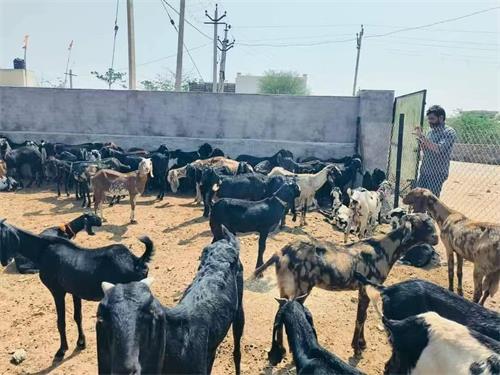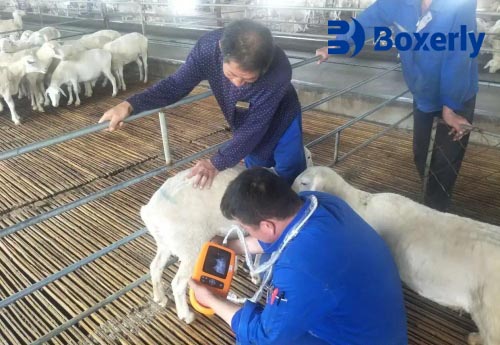As a sheep farmer, knowing whether a ewe is carrying a single lamb or twins is essential for efficient farm management. Singleton pregnancies and twin pregnancies require different approaches in nutrition, housing, and lambing supervision. One of the most effective tools we rely on is Veterinary ultrasound. This technology allows us to assess fetal numbers accurately, improve reproductive efficiency, and prevent unnecessary losses. In this article, I’ll explain how we use ultrasound to determine if a ewe is pregnant with one or two lambs, the science behind the process, and why it is a game-changer for modern sheep farming.

Understanding How Ultrasound Works in Veterinary Practice
Ultrasound, also called ultrasonography, is a non-invasive diagnostic technique that uses high-frequency sound waves—usually between 1.5 and 18 megahertz—to create images of internal organs and structures. When we use this tool on sheep, the machine sends short pulses of sound into the ewe's body. As these waves hit tissues and fluids of different densities (like a fetus or uterine fluid), echoes are produced and captured by a probe called a transducer. These echoes are converted into visual images in real time.
The most common ultrasound format used for pregnancy diagnosis in sheep is B-mode scanning (brightness mode), which produces two-dimensional grayscale images. We apply a transmission gel to the ewe’s abdomen to improve contact and clarity, then gently move the probe to locate the uterus and the fetuses.
Why We Need to Know Singleton or Twin Pregnancies
Knowing the number of lambs a ewe is carrying is critical for:
Nutritional Planning: Twin-bearing ewes need more energy and protein, especially in late gestation.
Lambing Assistance: Ewes with twins are more likely to have difficult births (dystocia).
Reducing Lamb Mortality: If we know twins are expected, we can monitor more closely at lambing.
Efficient Culling and Breeding: Ewes consistently bearing singles may be culled or bred differently to increase flock productivity.
When to Perform Ultrasound Scanning
The ideal time to scan sheep for pregnancy and fetal counting is between 45 and 90 days post-mating. Earlier than 45 days, the embryos may be too small to detect clearly. Later than 90 days, the fetuses grow large and may overlap in the uterus, making it harder to differentiate between one and two.
During the mid-gestation period (around 60 to 80 days), we get the best image clarity and accuracy for counting fetuses. At this stage, the fluid-filled uterus is visible, and we can see distinct embryonic structures, such as heads and spines.

How to Differentiate Singleton and Twin Pregnancies
As an experienced farmer, I work closely with our veterinarian to identify signs of twins versus a single lamb:
Fetal Location and Separation: We look for two separate fetal heads and spines in different areas of the uterus.
Fetal Movements: Observing independent movements in separate directions helps confirm multiple fetuses.
Multiple Heartbeats: Each fetus has its own heartbeat; skilled operators can identify more than one.
Repeated Scans: Sometimes, a follow-up scan confirms the count if the initial view is unclear due to fetal positioning.
It’s important to avoid counting the same fetus twice, so training and experience in image interpretation are key. An ultrasound operator who knows sheep anatomy and fetal development stages can provide very reliable results.
Transabdominal vs. Transrectal Scanning in Sheep
There are two main approaches to scanning sheep:
Transabdominal Scanning: Most common in ewes; performed with the ewe standing or restrained. The probe is applied to the lower abdomen.
Transrectal Scanning: Less common in sheep but used in very early pregnancy diagnosis (before 35 days). The probe is inserted into the rectum for closer imaging.
For routine twin detection, we rely on transabdominal scanning after day 45 of gestation. It's less invasive and efficient for flock-wide scanning.
Benefits of Ultrasound in Sheep Farming
From my experience, ultrasound has transformed our breeding program in the following ways:
Better Lamb Survival: Knowing which ewes carry twins allows us to give them extra feed and care.
Accurate Ewe Sorting: We can group ewes based on litter size, streamlining nutrition and housing.
Efficient Use of Labor: We focus attention where it’s needed—especially during lambing season.
Economic Gains: More live lambs mean better profitability per ewe per season.
In essence, ultrasound helps us make data-driven decisions, resulting in healthier lambs and more productive ewes.

Challenges and Limitations
Ultrasound isn’t without its challenges. A few issues we’ve encountered include:
Operator Skill: Accurate fetal counting depends heavily on the technician’s experience.
Fetal Overlap: In late pregnancy, it can be difficult to distinguish twins due to crowding.
Time Constraints: Scanning large flocks takes time and planning, especially during busy seasons.
Equipment Quality: High-resolution machines offer clearer images, but they come at a cost.
Despite these limitations, the benefits far outweigh the drawbacks. With good equipment and a skilled operator, we routinely achieve over 90% accuracy in twin detection.
Improving Accuracy: Tips from the Field
Here are a few practical tips we’ve adopted on our farm:
Scan at the Right Time: The 60–80-day window is best for counting.
Use a Full Bladder: A ewe with a full bladder often provides clearer images.
Minimize Stress: Handle sheep calmly to reduce movement and improve scanning accuracy.
Record Everything: We keep scanning records for each ewe to track productivity over time.
The Future of Ultrasound in Sheep Production
With technology advancing, 3D and even 4D ultrasound imaging may become more accessible to farmers in the future. These advanced modes offer better spatial understanding of fetal position and movement. Integration with digital data systems can also help track and manage flock performance more efficiently.
Eventually, we may see AI-assisted image recognition helping farmers and veterinarians interpret scans faster and more accurately—especially in large-scale operations.
Conclusion
Veterinary ultrasound is a powerful, reliable, and farm-friendly tool that helps sheep farmers like me manage our flocks more effectively. By accurately detecting singleton or twin pregnancies, it improves lamb survival, optimizes ewe care, and boosts overall farm productivity. While skill and equipment matter, with the right approach, even small farms can reap big benefits from this simple technology. It’s not just about seeing into the womb—it’s about planning for the future of every lamb.
References
Sheep Ultrasound Pregnancy Scanning Guide - University of Guelph
Veterinary Reproductive Ultrasonography - MSD Veterinary Manual
Improving Flock Productivity with Pregnancy Scanning - NSW Department of Primary Industries
tags:
Text link:https://www.bxlultrasound.com/ns/805.html


